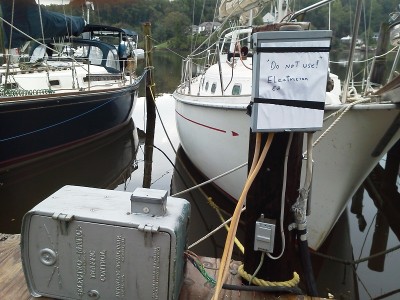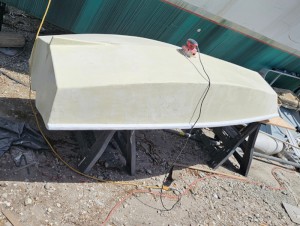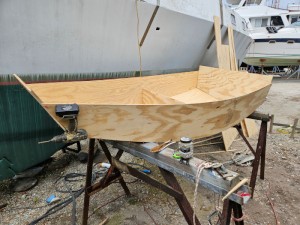Kaimusailing
s/v Kaimu Wharram Catamaran
| Vessel Name: | Kaimu |
| Vessel Make/Model: | Wharram Custom |
| Hailing Port: | Norwalk, CT |
| Crew: | Andy and the Kaimu Crew |
| About: | Sailors in the Baltimore, Annapolis, DC area. |
17 April 2024 | St Marys, GA
Dinghy Skeg
I was suffering with what seemed like a cold and also had allergy symptoms. I awoke and felt fine. The green pollen that was coating everything was gone. Maybe it will return.
07 April 2024 | St. Marys, GA
Clammy Hands
Items came in from TEMU, the Chinese cut rate retailer. One was a nice little drone that cost about twelve and a half dollars. It looked like an easy thing to play with while I coughed and sneezed. I was fighting a summer cold, even though it is not summer elsewhere, it seems like it here. A nice [...]
02 April 2024 | St. Marys, GA
Sun Doggie
After laminating the cedar strips onto the gunwales of the dinghy I found the screws I used wouldn’t come out. The epoxy had seized them. The screw heads were stripped so I cut a straight slot in the heads with the cut off wheel. The cedar smoked when the screw heads got red hot. I could remove [...]
21 March 2024 | St. Marys, GA
Just Add Water
The rainy weekend started off with overcast and fog but no rain. It looked like I might be able to get something done on the D4 dinghy. I wanted to change the bow seat which is really the bow deck. The sailing option uses the deck to hold the freestanding mast. I didn’t like how the deck looked, [...]
01 March 2024 | St. Marys, GA
D4 Dinghy Alternative Seats
The rain event was more wind than rain, strong winds with gusts up to 44 mph. We drove into town to see what the harbor was like. There was a small sailboat that had dragged anchor and was sitting close to shore. The tide was out. We left and played with Bleu at Notter’s Pond.
23 February 2024 | St. Marys, GA
D4 Inside Seams
Day two of the dinghy build started out with me finishing wiring the hull bottoms together on the centerline of the bottom panels. This was much easier than the wiring of the chine edges of the bottom panels and the side panels.
A Slight Miscalculation...

Because the water heater is mounted above the holding tank in the port aft storage space, the heater couldn't be plumbed until the holding tank was checked out. There was no sense in completing the heater installation if the holding tank had to be replaced. Because the tank had sat for so long, I was advised the contents probably had congealed into a concrete mass of poop. When I checked it with a long paint mixer attachment on a drill, it turned out it was still fluid. Now all we had to do is get it pumped out, then proceed with the plumbing.
The water system in the port hull runs on a demand pump forward at the water tank. It turns on whenever a faucet is opened. All the faucets have microswitches in them. The cold water line runs to the vanity sink amidships, then to the head where it branches to feed the sink in the head and the inlet of the water heater. The outlet of the water heater runs to the sink in the head. There is no hot water to the vanity.
The system can't be used until it is completely installed. The commode is separate and is fed by the shower/sink sump and it discharges aft into the holding tank. The sump also has a discharge pump that maintains the water level below the sole.
The electrical installation includes wiring the solar charge controller to the UPS batteries and the batteries to the AC/DC panel. Previously I had modified the UPS so that its battery pack could be connected to external batteries to supplement the amount of storage. The connections were made to a pair of terminal blocks and then to the charge controller. The charge controller is connected to battery first, then the solar panels can be connected to the charge controller. The charge controller indicated the batteries were good, but there was no indication that the solar panels were charging. My meter was dead, so I used a test lamp to see that there was power at the terminal blocks. I couldn't see any power from the panels. I needed to put a new battery into the meter. Then I found 24 volts at the terminal blocks. This explained everthing, the panels only produce about 22 volts open circuit, so they couldn't charge the batteries. The test lamp had burned out on the first test and was dead when I tried to check the solar panels. This was a major miscalculation, I had thought the UPS ran on 12 volts DC, but they were wired differently and combined for 24 volts. This meant I couldn't use the ship's DC power to feed the UPS batteries and made my scheme to use the UPS as my AC source impractical.
I disconnected and removed the UPS. Now I would need a 12 volt battery to connect to the charge controller before I could connect the solar panels to it. The battery store was closed for the Labor Day weekend. When it reopened I found they were out of size 27 deep cycle batteries and I'd have to come back in a few days. I could continue installation and test with a temporary battery.
The DC panel has 8 breakers and we needed more. Fortunately we had fuse panels, so any load that had its own switch would be put on the fuse panel, and any load that needed a switch would be put on the breaker panel. An example of a load with a switch would be the VHF radio, an example of a load without a switch would be the watermaker. BEP, the manufacturer of the DC breaker panel, doesn't use buss bars on the breakers, they individually are wired to a separate buss bar. This is probably the result of New Zealand code.
The 5 circuit fuse panel was wired to the VHF radio, the head, the shower sump pump, the fresh water system pump, and the chart table florescent light.
We had a deluge from the remains of tropical storm Lee that lasted about a week. The work continued inside the boat and the fresh water pump was installed along with the rest of the electrical. The size 27 batteries came in and I put them in. The AC power on the dock failed when the box came loose of the piling it was mounted on, and dropped to the dock with a shower of sparks. The UPS was already out of the picture and the inverter in the starboard hull was put into service. It lasted about an hour, the starboard battery turned out to be bad. There was more work to do, so another pair of size 27 batteries were installed on the starboard side.
We now had brand new batteries all around.
The plumbing work was completed in the port hull. We had already installed the tank and the deck fill and the head was ready to hook up with the new pump. The vanity faucet and new pump were installed with a line from the tank to the pump, the pump to a tee and one side of the tee feeding the vanity faucet and the other feeding a second tee which fed the water heater and cold water tap in the head. The water heater was hooked up to the incoming feed from the pump and the outgoing feed to the hot water tap in the head.
With everything hooked up the system was tested to see if the pumps worked, the faucet switches worked, and if there were any water leaks in the system. It all seemed to work well and I put about 30 gallons of water into the tank.
A few loose ends were attacked, some epoxy work was done on abrasion of the port gunwale and the ultralight dinghies needed repairs. This took a few days due to the amount of clamps needed.
I found some water in the port bilge near the water pump. A further search revealed the water wasn't coming from the pump, but from forward, from the tank. Now I had to remove the 30 gallons of water and find the leak.
The little space just aft of the water tank was full with about 5 gallons of water. Downstream or aft of that, was only an inch or two of water in the bilge below the pump. I pumped out the tank and transferred the water to the starboard tank. The tank was removed and the resultant water was cleaned up.
I disassembled the tank back at the cottage and rinsed any residue off it. This is a flexible tank by Plastimo which has a pvc water bag inside of a vinyl/nylon outer bag. The idea is to protect the water bag from any outside abrasion. The outer bag has loops to tether the tank in place. If there is sand or debris between the tanks, they can fail due to abrasion. When I rinsed off any residue from the two bags and reassembled them I was sure there was no leak in the tank itself. It must be the inlet or outlet fittings, yet I felt water leaking from the bottom outlet fitting, which is where water that leaked out of any part of the tank would end up.
When I reinstalled the tank, confident it would not leak, it leaked. I tried reinstalling the outlet fitting with and without the O-ring. It made little difference. The O-ring was not the same size as the input 0-ring. I remember grabbing an available O-ring from spares when I first installed the tank. After a trip to the hardware store, I had an identical correct O-ring and reassembled the tank and reinstalled it.
Each time I tested the tank I poured a 5 gallon container of water into the inlet on deck and each time it leaked I had to sponge out the water in the bilge and pump out the tank into the empty container. Eventually I would have to go back to th cottage to fill the container, as there was no running water at the dock.
When I tested the tank with the new O-ring, it still leaked. There must be a leak in the inner bag. I would have to remove it again and test it up on deck. It began to rain. It was almost dinner time anyway. When I got to the cottage and checked the forecast, it was rain, rain overnight, and rain the next day up to 2 inches.






